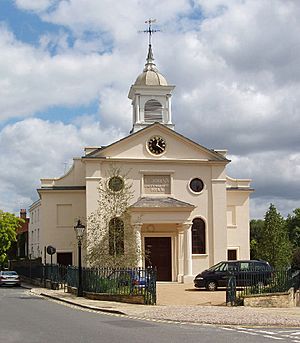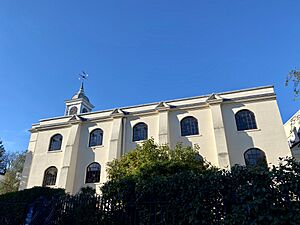St John's Downshire Hill facts for kids
Quick facts for kids St John's Church, Downshire Hill |
|
|---|---|

St John's Downshire Hill, Hampstead
|
|
| 51°33′21″N 00°10′11″W / 51.55583°N 0.16972°W | |
| OS grid reference | TQ 26982 85697 |
| Country | England |
| Denomination | Church of England |
| Churchmanship | Conservative evangelical |
| History | |
| Dedication | St John |
| Architecture | |
| Heritage designation | Grade I listed |
| Completed | 1823 |
| Administration | |
| Parish | St Stephen with All Hallows |
| Deanery | North Camden |
| Archdeaconry | Hampstead |
| Diocese | Diocese of London |
St John's Downshire Hill, Hampstead, is a special kind of church in London. It's called a proprietary chapel and belongs to the Church of England. You can find it in Downshire Hill, Hampstead. Even though it's often called St John's Church, it's officially known as a chapel. It's important not to confuse it with another church nearby, St John-at-Hampstead, which is a different parish church.
Contents
History of St John's
Building the Church
Back when the area around Downshire Hill was growing, people thought a new church was really needed. In 1812, a piece of land on Downshire Hill was bought for the church. In 1817, it was passed to three people: a minister named James Curry, a builder named William Woods, and a lawyer named Edward Carlisle. Curry offered to pay for the building if he could be the minister. The church was named after St John, possibly because it was meant to help the main parish church, St John-at-Hampstead.
The church building was finished in 1823. The very first service was held on October 26, 1823. The first minister was William Harness, a friend of the famous poet Lord Byron. Curry had become ill and passed away soon after the church opened.
A Big Problem in 1832
In 1832, a man named John Wilcox bought the church property. He wanted to lead services there with an evangelical style of worship. However, he faced opposition from Samuel White, who was the main minister of the parish of St John, Hampstead. At that time, Downshire Hill was part of White's parish, and he needed to give permission for services to be held.
Wilcox said he would preach even if he wasn't allowed to as an Anglican minister. White told him he didn't have permission, but Wilcox continued. So, White took Wilcox to a special church court called a consistory court. The court decided that White was right.
However, many local people supported Wilcox. The poet John Keats, who lived nearby, had even called White "the Person of Hampstead quarreling with all the world." Important local figures, like Lord Galloway and Sara Coleridge, signed a petition to support Wilcox. A church magazine at the time strongly criticized the court's decision. It said that a church building could be turned into a ballroom or a theater, but it couldn't be a Church of England place of worship without the main minister's permission.
Because of this court decision, the church had to close until 1835. John Wilcox stayed in the area and started a school for local children before he passed away in December 1835.
Years of Change (1835–1916)
In 1835, a new minister named John Ayre was found, and Dr. White approved of him. Ayre served as minister from 1835 to 1855, becoming the longest-serving minister at St John's for many years.
In 1862, the church's property ownership was changed to a freehold, which meant it was fully owned without special conditions.
People needed more space for church services, so plans were made for a new, larger parish church nearby. In 1863, St John's was considered for this, but it was too small. Even though 1,370 people once attended a service there, its capacity was only 900. A new church, St. Stephen's, was built nearby instead.
Robert Baker Girdlestone, a well-known scholar, was the minister of St John's from 1889 to 1903.
Modern Times (1916–Present)
During World War I, the church faced money problems. In 1916, Mr. Albert Leslie Wright bought the church property. His father, Rev. Henry Wright, had been a minister there earlier. Leslie Wright then rented the church back to the congregation for a very small fee. In his will, he made sure that the church would continue to follow evangelical beliefs after he died.
Leslie Wright passed away in 1938. The church continued to operate this way until 2003, when the congregation finally bought the property from his trustees.
St John's has always had strong connections to Christian mission work around the world. From early records, donations to missionary societies were the biggest expense. Several ministers from St John's were involved in overseas work, including Douglas Butcher, Douglas Paterson, and Kenneth Howell.
Tom Watts became the senior minister of St John's in January 2018.
The church follows a conservative evangelical tradition. This means they have specific beliefs about leadership and the role of women in the church. They receive special guidance from the Bishop of Ebbsfleet, who is currently Rob Munro.
The Church Building
The church building is a Grade I listed building. This means it's very important historically and architecturally, and it's protected. It has a cream-painted front with a classic Doric porch, columns, and a small dome on top. Inside, there's a main hall with galleries on three sides.
The church doesn't have a separate area for the altar. Instead, it has special panels and a border with Bible verses written in gold. These features show that the church was built at a time when preaching was very important in evangelical Anglican churches.
The original wooden box pews, which are like long benches, are still in the church. During renovations in 2003-2004, these pews were moved to the sides.
The window at the east end of the church has an eagle design, which is a symbol for St John and the Bible's Gospel. In the west gallery, there's an organ built in 1873. The clock on the front of the building was made in 1823 by John Moore and Son.
The building has been renovated several times over the years, including in 1896, 1950 (after war damage), 1973, 1982, and 2004. During the 2003-2004 renovations, new foundations were put in, and an underground area was built.
St John's: A Unique Chapel
In the 1800s, there were more than 50 proprietary chapels in London. But today, St John's Downshire Hill is the only one left in the Diocese of London. It's one of only a few in all of England.
Being a proprietary chapel means it's financially independent from the main Church of England. It doesn't give money to the Diocese, and it doesn't receive money from them either. The people who attend St John's pay for all the running costs, including staff salaries and keeping the building in good shape.


